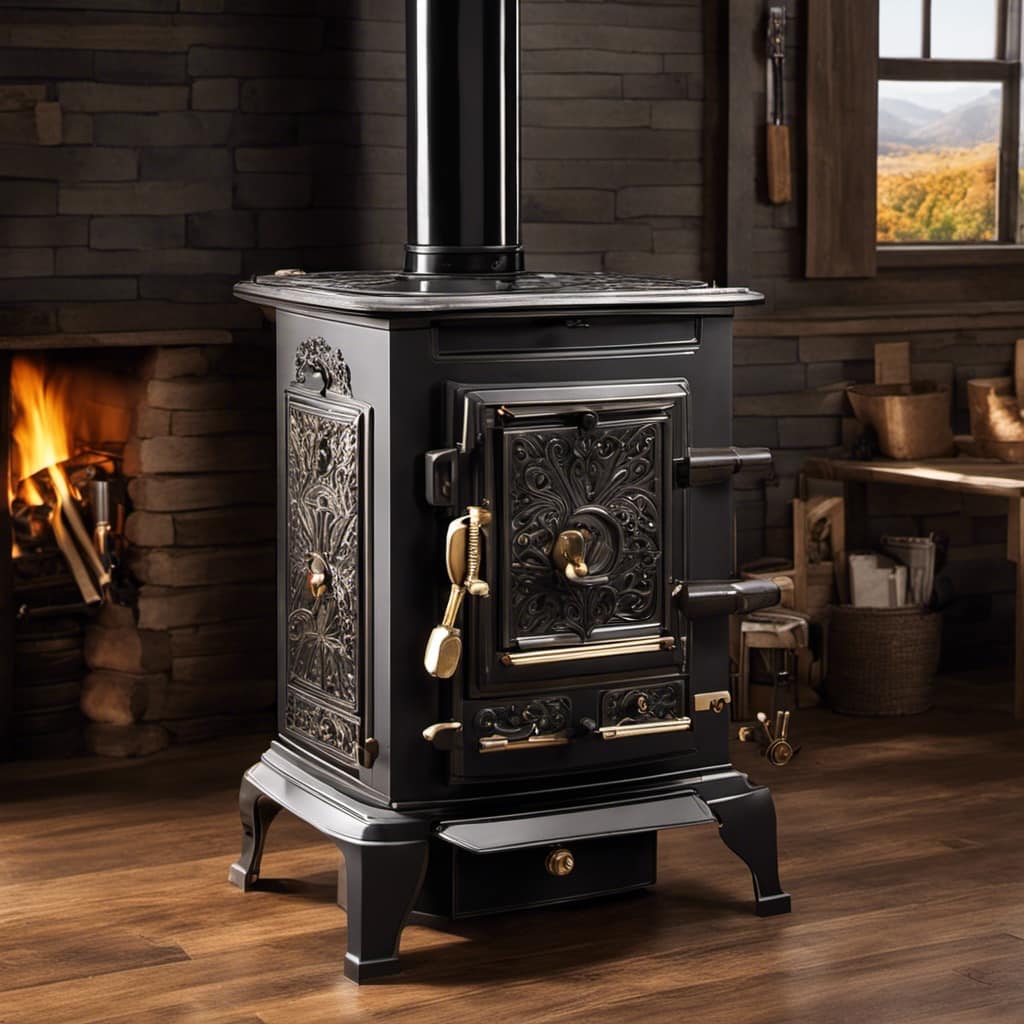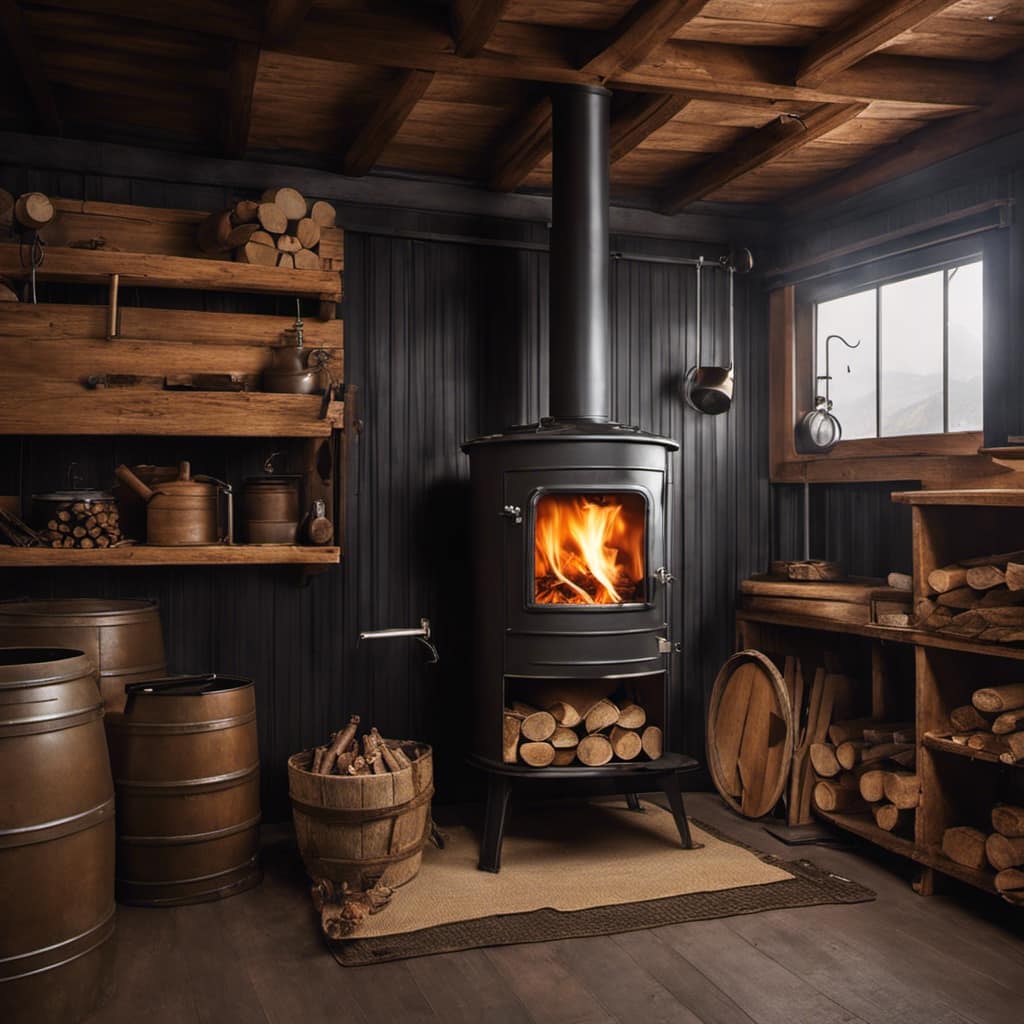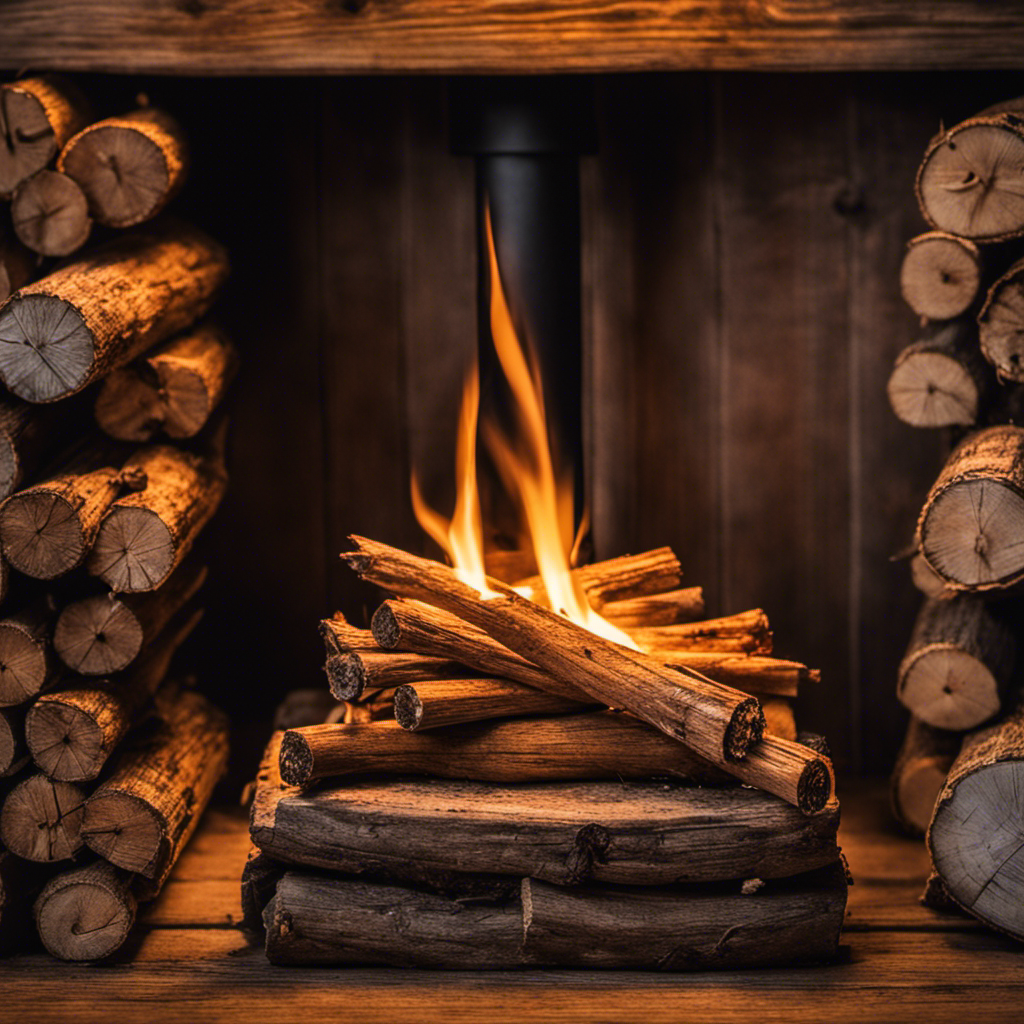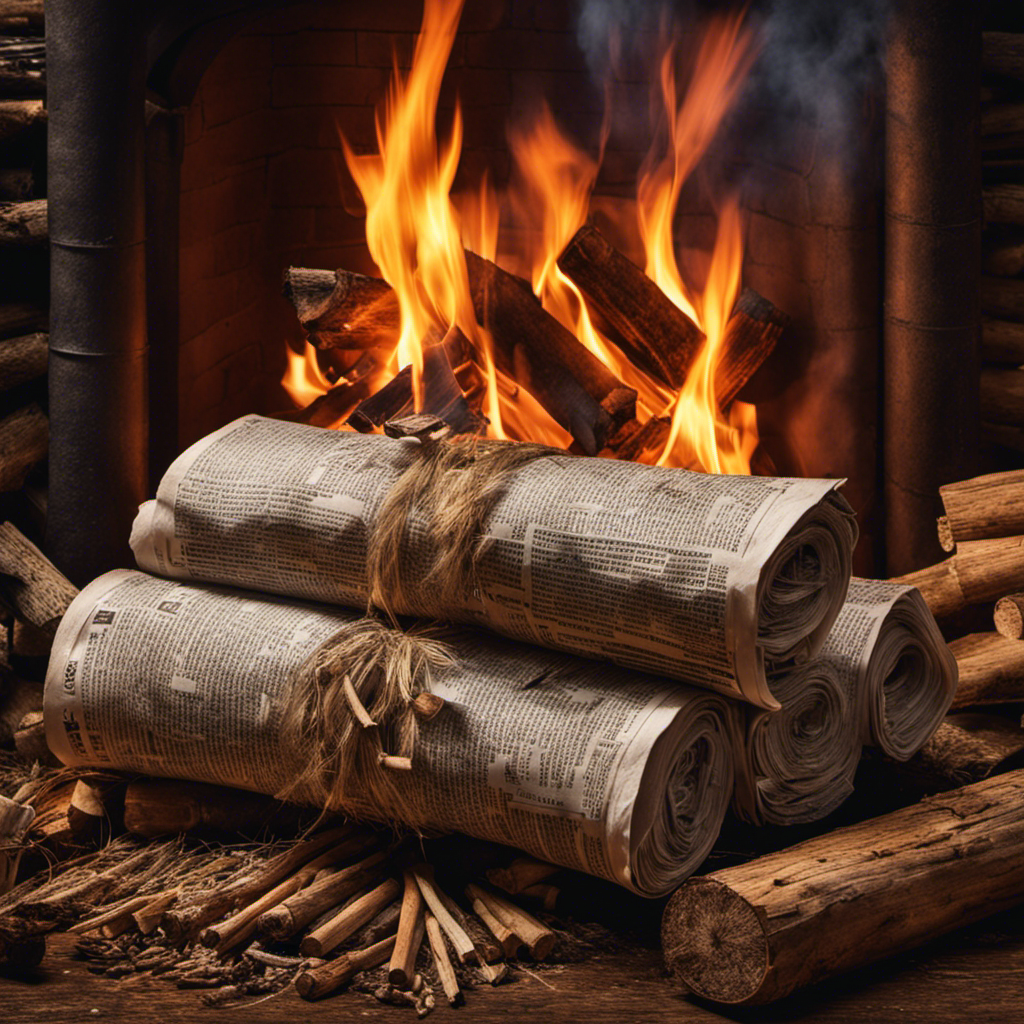Growing up in a snug cabin nestled deep in the woods, I learned from a young age how to skillfully manage a fire in a wood stove. Every crackle and pop was a lesson in keeping the fire ablaze and warm throughout the entire night.
Now, I want to share that knowledge with you. In this article, I’ll guide you through the steps of banking a fire in a wood stove, ensuring warmth and comfort in even the coldest of nights.
Let’s get started.
Key Takeaways
- Fire banking involves arranging logs in a specific way to control intensity and duration.
- Hardwoods like oak and maple are ideal for banking fires.
- Close the damper to reduce airflow and slow down combustion.
- By following these tips, you can maximize heat output and extend burn time.
Understanding the Basics of Fire Banking
I’m currently learning about the basics of fire banking in order to better understand how to efficiently bank a fire in a wood stove.

Understanding fire behavior is crucial when it comes to banking a fire. Fire has a natural tendency to spread and consume fuel, but by banking a fire, you can control its intensity and duration.
Fire banking involves arranging the logs in a specific way to create a slow-burning, long-lasting fire. By reducing the airflow, you can limit the amount of oxygen available to the fire, resulting in a slower burn.
This technique has several benefits, including conserving wood and prolonging the heat output. Fire banking is especially useful during the night when you want to keep the fire burning but not at full intensity.
Choosing the Right Firewood for Banking
To create the perfect banked fire, it’s important to choose firewood that’s both dense and dry, as well as split into smaller pieces for better airflow. When it comes to choosing firewood for banking, there are a few key factors to consider:

Wood Species: Different wood species have different burning properties. Hardwoods like oak and maple are ideal for banking fires, as they burn longer and produce more heat compared to softwoods like pine.
Moisture Content: It’s crucial to ensure that the firewood is properly seasoned and has a low moisture content. Wet or green wood won’t burn efficiently and can create excessive smoke and creosote buildup in the chimney.
Storage: Properly storing firewood is essential to maintain its quality. It should be stored in a well-ventilated area, off the ground, and protected from rain and snow. This helps to ensure that the firewood remains dry and ready for use.
Preparing Your Wood Stove for Fire Banking
I carefully cleared out the ashes from my wood stove in preparation for banking the fire tonight. As I reached for my tools, I made sure I had everything I needed to properly prepare the wood stove. Here are the essential tools for fire banking:

| Tool | Purpose |
|---|---|
| Ash shovel | To remove ashes from the stove |
| Poker | To rearrange the burning logs |
| Firewood | To fuel the fire |
| Firewood rack | To store and organize firewood |
By having these tools on hand, I could ensure a successful fire banking experience. With the ashes cleared and the tools ready, I was now ready to proceed to the next step – a step-by-step guide to banking a fire in a wood stove.
Transition: Now that I had prepared the wood stove, it was time to follow a step-by-step guide to properly bank the fire and ensure a long-lasting heat source.
Step-by-Step Guide to Banking a Fire in a Wood Stove
After gathering all the necessary tools, I carefully followed the nine-step guide to banking a fire in my wood stove.
- Close the damper to reduce airflow and slow down the combustion process.
- Arrange the remaining logs in a tight stack to create a bed of coals that will slowly burn.
- Use small pieces of kindling to fill any gaps between the logs, ensuring a consistent burn.
- Avoid using wet or green wood, as it will create excessive smoke and decrease efficiency.
- Don’t overload the stove with too much wood, as it can lead to incomplete combustion and wasted fuel.
- Place a layer of ash on top of the logs to insulate the fire and prolong its burn time.
- Check the stove’s temperature regularly to ensure it stays within a safe and efficient range.
- Avoid opening the stove door frequently, as it will disrupt the banking process and release heat.
- Finally, monitor the fire closely to ensure it’s properly banking and adjust the damper as needed.
Are There Different Techniques for Banking a Fire in a Wood Stove?
Yes, there are different techniques to bank a fire in a wood stove. One method is to arrange large logs at the back of the stove with smaller pieces in front, creating a slow-burning fire. Another technique involves closing down the air vents to restrict oxygen and maintain a low, steady burn.
Tips and Tricks for Maximizing Efficiency in Fire Banking
The key to maximizing efficiency in fire banking is to carefully arrange the logs and use small pieces of kindling to ensure a consistent burn. By strategically placing the logs in a specific pattern, you can maximize heat output and extend the burn time of your fire. To help visualize this process, here is a table outlining the recommended log arrangement for optimal efficiency:

| Row 1 | Row 2 | Row 3 | Row 4 | Row 5 |
|---|---|---|---|---|
| Large | Small | Large | Small | Large |
| Large | Small | Small | Small | Large |
| Large | Small | Large | Small | Large |
In this configuration, the larger logs act as a base, while the small pieces of kindling provide a consistent source of fuel. This arrangement promotes better airflow, allowing for a more efficient burn. By following these tips and tricks, you can maximize the heat output of your fire and extend its burn time, keeping your home warm and cozy for longer periods.
Frequently Asked Questions
How Long Can a Fire Be Banked in a Wood Stove?
I’ve learned that it’s essential to consider the long-term effects of banking a fire in a wood stove. Safety precautions, such as ensuring proper ventilation and using the right amount of fuel, should always be followed.
What Are the Potential Dangers of Banking a Fire in a Wood Stove?
Banking a fire in a wood stove can be dangerous. The potential dangers include carbon monoxide poisoning and chimney fires. It’s important to properly ventilate the stove and regularly clean the chimney to prevent these hazards.
Can Any Type of Wood Be Used for Banking a Fire in a Wood Stove?
Yes, any type of hardwood can be used for banking a fire in a wood stove. Oak, maple, and hickory are popular choices. To ensure proper banking, stack the wood tightly and close the dampers to control the airflow.

Is It Necessary to Clean the Wood Stove Before Banking a Fire?
Before banking a fire in a wood stove, it is crucial to clean it. Cleaning the wood stove ensures optimal performance and reduces the risk of fire hazards.
What Are Some Signs That Indicate a Fire Has Been Properly Banked in a Wood Stove?
When a fire is properly banked in a wood stove, there are signs to look for. The flames should be low, with a bed of glowing embers. It’s important to maintain the banked fire by adding small amounts of fuel as needed.
Conclusion
In the dance of the wood stove, fire banking is a graceful art. By understanding the basics, choosing the right firewood, and preparing your stove, you can master this technique.
Follow the steps and tips provided to create a well-controlled fire that will keep you warm throughout the night. With practice, you’ll find yourself in perfect harmony with the rhythm of the fire, maximizing efficiency and enjoying the cozy embrace of your wood stove.

Growing up surrounded by the vast beauty of nature, Sierra was always drawn to the call of the wild. While others sought the comfort of the familiar, she ventured out, embracing the unpredictable and finding stories in the heartbeat of nature.
At the epicenter of every remarkable venture lies a dynamic team—a fusion of diverse talents, visions, and passions. The essence of Best Small Wood Stoves is crafted and refined by such a trio: Sierra, Logan, and Terra. Their collective expertise has transformed the platform into a leading authority on small wood stoves, radiating warmth and knowledge in equal measure.











